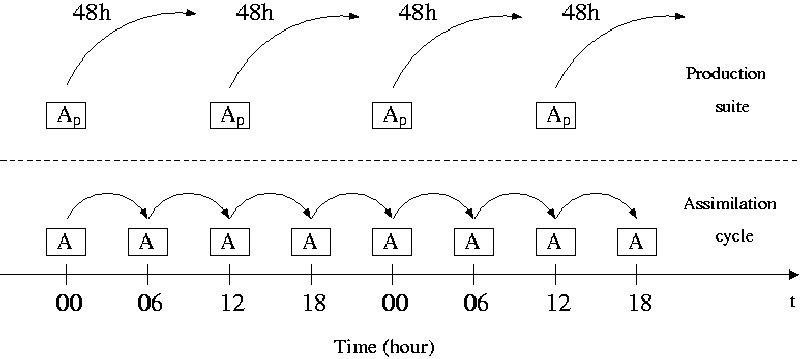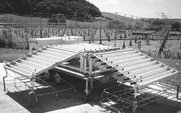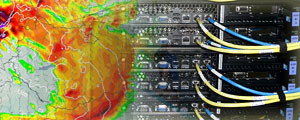The process of data assimilation means providing initial conditions for numerical weather prediction models taking into account available information about the actual state of the atmosphere. Main available information are meteorological observations and the background (an earlier forecast of the model valid at the time of the actual initial conditions). State of the art data assimilation methods (e.g optimal interpolation, variational assimilation) provide the initial conditions by a statistically optimal combination of observations and the background, taking into account the reliability of these information components (in a statistical sense too, i.e. in the form of error covariance matrices). In case of regional models, data assimilation can be replaced by the interpolation of initial conditions originating from global models or other regional models covering larger area. However, such interpolated initial conditions are unable to efficiently represent meso scale meteorological systems because the real meteorological information originates from a coarser grid. Below the resolution of the given coarser grid the interpolation implies only noise but not meteorological information. It is important thus to provide the initial conditions directly on the high-resolution grid of our actual model, which can be done only by implementing a regional data assimilation system. Naturally, benefits can only be gained from a high-resolution data assimilation system if the observing system is approximately of similar spatial resolution as the model. For this reason research on new observing techniques is of high importance in data assimilation developments. In today’s high-resolution data assimilation systems besides the conventional surface and radiosond observations, aircraft, GPS, satellite, wind-profiler and radar data are applicable too, which detect the distribution of meteorological parameters in high-resolution. Based on the above concern, at OMSZ, large emphasis is put on the development of data assimilation systems for regional models (ALADIN and AROME).
Data assimilation system of the ALADIN model
Developments related to data assimilation started during the summer of 2000 at OMSZ with the aim of improving initial conditions of the ALADIN model. For the determination of surface and soil initial conditions the optimal interpolation, while for providing atmospheric initial state the (three dimensional) variational assimilation (3d-var) was chosen as a methodological basis. The first experimental application started to run during the summer of 2001 on a regular basis using the resources of an SGI Origin 2000 computer (16 processors) and benefiting from surface and radiosond observations. In the period of 2002–2005 developments continued by increasing the amount of observational data used in the system (introduction of several satellite and aircraft data as well as wind-profilers). The ALADIN 3d-var local assimilation system became an operational application in May 2005, which means that it became an application serving the duty forecasting process and different end users. Since the operational introduction the emphasis was put on improving background error simulation for sampling the background error covariance matrix, as well as further increasing the amount of observation assimilated and removing their possible systematic errors. Also attempts have been taken to extend the variational assimilation in time, namely to use a 4d-var or a 3d-fgat approach. Main characteristics of the presently operational ALADIN assimilation system are listed in the table below.
|
Atmospheric assimilation scheme |
3d-var (three-dimensional variational assimilation) |
|
Surface/soil assimilation scheme |
Optimal interpolation |
|
Background |
Own (ALADIN) 6 hours forecast |
|
Background error simulation technique |
Ensemble method (downscaled AEARP ensemble data assimilation and ALADIN regional ensemble data assimilation) |
|
Data assimilation cycle frequency |
6 hours |
|
Lateral boundary conditions |
Main characteristics of the ALADIN data assimilation system

Schematic graph of the data assimilation cycle used in the ALADIN model
Observations used in the ALADIN data assimilation system
Development of a data assimilation system for AROME
A high-resolution data assimilation system specifically for the AROME model is under development. The AROME 3DVAR system has been implemented operationally in march 2013 using conventional (surface, radiosond, aircraft measurements) observations in a 3 hourly data assimilation cycle. Future directions for the development of this system are as follows:
- Increase of observation density for the observation types used in the ALADIN model: all the observation types used in the ALADIN operational data assimilation will be used in the AROME system as well, but in the highest possible density. Limits of applicable observation density are to be explored as the function of background and possible observation error correlation length-scales.
- Assimilation of new, high-resolution, asynoptic observations: it is a great challenge to feed high-resolution AROME forecasts with meaningful initial conditions, as it requires a high input observation density as well. The challenge is even more pronounced due to the lack of synoptic (surface and radiosond) observations at the asinoptic times (03, 09, 15, 21 UTC) of the planned 3 hourly data assimilation cycle. The above reasons necessitate the use of remotely sensed high resolution observations available at asynoptic times. Such observations are radar (reflectivity and radial wind) data as well as GPS zenith and slant delays, which, as a consequence, are planned to be included to the AROME data assimilation system.
References
- Adamcsek E., Bölöni G., Csomós P. és Horányi A., 2010: Application of the Ensemble Transform Kalman Filter technique at the Hungarian Meteorological Service: Preliminary results, Időjárás, 114, pp 21-39
- Bölöni G., 2006: Development of a variational data assimilation system for a limited area model at the Hungarian Meteorological Service. Időjárás, 110, pp 309-327.
- Bölöni G. és Horvath K., 2010: Diagnosis and tuning of background error statistics in a variational data assimilation system, Időjárás, 114, pp 1-21.
- Brousseau P., Berre L., Bouttier F., Desroziers G., 2011: Background-error covariances for a convective-scale data-assimilation system: AROME–France 3D-Var, Q. J. R. Meteorol. Soc, 137, 409–422.
- Fischer C., Montmerle T., Berre L., Auger L., Stefanescu S. 2005: An overview of the variational assimilation in the Aladin/France numerical weather prediction system. Tellus, 131, 3477-3492.
- Randriamampianina, R., 2006: Impact of high resolution observations in the ALADIN/HU model. Időjárás, 110, 329-349.
- Randriamampianina R, Iversen T, and Storto A. 2011. Exploring the Assimilation of IASI Radiances in Forecasting Polar Lows. Q. J. R. Meteorol. Soc. 137, 1700–1715
- Storto, A and Randriamampianina, R. 2010, Ensemble variational assimilation for the representation of background-error covariances in a high-latitude regional model, J. Geophys. Res., 115, D17204














